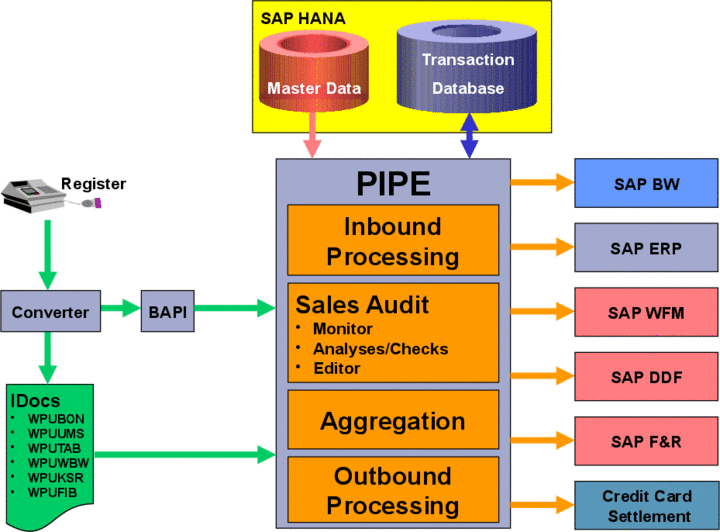 POS Data Transfer and Audit
POS Data Transfer and Audit
POS Data Transfer and Audit refers to the collection of point-of-sale (POS) transaction data from connected stores. POS transaction data is received by the repository in the form of transaction logs (TLOGs), which are processed by the POS Inbound Processing Engine (PIPE).
Once the POS transactions are received, PIPE performs several processing activities, such as master data verification, sales auditing, POS transaction data summaries, and sending of POS transaction data to follow-on applications.
Additionally, POS transaction data is made available to consuming applications through virtual data models and individual SAP HANA views. For more information, see SAP HANA Content for SAP Customer Activity Repository.
Implementation Considerations
All references to POS Data Management
in this documentation refer to the software component (version RTLPOSDM 200
or higher) included in the SAP Customer Activity Repository application and not to the SAP POS Data Management 1.0 application.
If you have previously implemented SAP POS DM, pay particular attention to the new features of the POS Data Management software component that are only available in the SAP Customer Activity Repository.
The following features available in SAP POS DM 1.0 SP01 or higher, are not supported by the POS Data Management software component in SAP Customer Activity Repository:
Loss Prevention Analytics Analysis Tools
POS In-Memory Analytics
Integration
PIPE uses processing tasks to send POS transaction data to the following applications:
SAP ERP for Retail
Sales data using IDoc WPUBON, IDoc WPUUMS, and IDoc WPUTAB
Financial transaction data using IDoc WPUFIB
Goods movement data using IDoc WPUWBW
SAP NetWeaver Business Warehouse (POS data supplied to BI Content for POS Analytics, Trade Foundation Analytics and Loss Prevention Analytics)
SAP Forecasting and Replenishment
SAP Workforce Management
SAP Demand Management Foundation
Credit card settlement applications
The following figure represents the data flow in PIPE:

POS Inbound Processing Engine
Features
The POS Data Management software component allows you to do the following:
Collect and process transactions posted from individual stores using PIPE.
PIPE can process the following data:
Sales and returns including the related tax data and discount information
Means of payment data
Financial transactions
Goods movements
Totals records and cashier statistics
POS data can be received by PIPE in different formats such as IDocs of message types WPUBON, WPUUMS, WPUTAB, WPUWBW, WPUFIB and WPUKSR or also in BAPI format. Furthermore, you can generate POS transactions manually using the POS Workbench.
Verify POS transactions against master data.
PIPE verifies POS transactions against master data available from a source SAP ERP system. PIPE accesses this master data using views included in SAP HANA Live for SAP ERP and SAP HANA Content for SAP Customer Activity Repository.
Perform checks.
PIPE checks for the following:
Duplicate Transaction Numbers
Gaps in receipt numbers
Balanced sales and tender totals
Receipt data as compared to cash desk totals
Credit card data
Perform sales auditing.
POS Data Management includes the POS Workbench, which allows you to perform the following sales audit activities:
Manually verify POS transaction data transfer
Analyze error an other messages
Display transaction processing history and follow-on documents
Search for POS transactions
Edit POS transactions
Summarize POS transaction data.
You can obtain summaries of POS transaction data by using the on-demand aggregation when sending POS data to follow-on systems or by explicit formation of aggregates.
Maintain rules for assigning order channel values to POS transactions.
Associate a customer number with acquired POS transactions.
This is only possible when customer data is available from either an SAP Customer Relationship Management (SAP CRM) or a third–party CRM system.